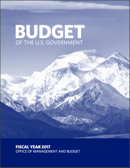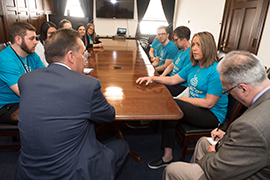 Earlier today, President Barack Obama released his final budget request to Congress for the upcoming Fiscal Year 2017. As he did with last year’s request, President Obama’s budget reaffirms his commitment to help families gain access to high-quality child care and early education.
Earlier today, President Barack Obama released his final budget request to Congress for the upcoming Fiscal Year 2017. As he did with last year’s request, President Obama’s budget reaffirms his commitment to help families gain access to high-quality child care and early education.
President Obama's FY 2017 budget proposes $82 billion in mandatory CCDF spending over the next ten years. Based on the annually investment of $2.917 billion in mandatory funding, this proposal would represent a $53 billion increase overall. With regards to discretionary child care funding, the President requested just under $3 billion ($2.961) in CCDBG funding for FY 2017, which is a $160 million increase from FY 2016 and over $400 million more then what’s authorized for the next fiscal year in the Child Care and Development Block Grant Act of 2014. Of the total funds requested, $127.2 million aims to improve the quality of infant and toddler care, and $40 million to states and local communities to develop, implement, and evaluate new, innovative models of providing care.
This nearly $1 billion in new money for early childhood education includes:
- $9.6 billion for Head Start; would increase total investment by $434 million and includes a set-aside of $645 million to expand Early Head Start and the Early Head Start-Child Care Partnerships,
- $292 million would be dedicated to increase the number of children attending Head Start in a full school-day and-year program,
- $1.3 billion for the Preschool for All Initiative. Funds would be to support states to expand the number and availability of high-quality preschool programs to serve four-year-olds from low and moderate income families, as well as to improve existing programs;
- Extends and expands evidence-based, voluntary home visiting programs;
- $350 million for Preschool Development Grants, which is an increase of a $100 million for both the authorized funding level in the recently enacted Every Student Succeeds Act, and what was appropriated in FY 2016;
- A slight increase ($27 million) for programs under Title I;
- A $55 million increase for Promise Neighborhoods; and
- Proposes again to triple the maximum Child and Dependent Care Tax Credit (CDCTC) for families with children under age five (to $3000 per child) and be made available to families with incomes of up to $120,000.
Every year, the President submits a budget blueprint to Congress outlining his annual spending priorities. After the budget is submitted, Congress follows by, if agreed upon, proposing and passing their budget resolutions. If Congress can reconcile a budget resolution between the two chambers, the appropriators in both the Senate and the House of Representatives are then required to pass 12 appropriations (spending) bills annually funding the government through the current and/or next fiscal year, using the budget resolution as a guideline.

However, due to the 2016 Presidential election, a final FY 2017 budget being signed into law is not likely until late December. It’s also possible that a continuing resolution may be enacted until the spring of 2017, leaving the new Administration and the 115th Congress to pass a budget.
Additional resources:
- Read the Fact Sheet on the FY 2017 Budget from the White House
- Review the entire FY 2017 budget





